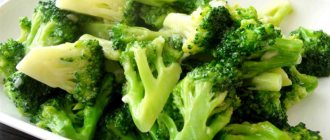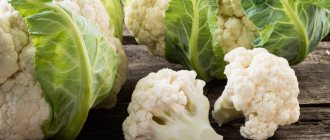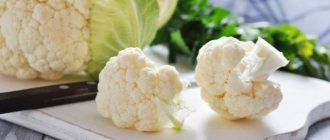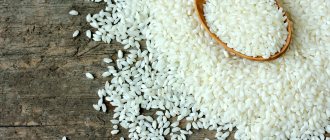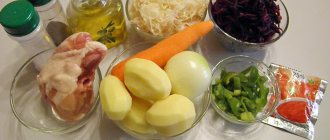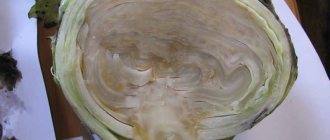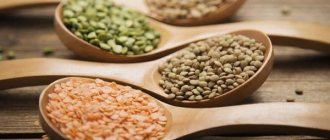Vegetables are necessary for humans; they saturate the body with vitamins and nutrients, strengthen the immune system and help normalize intestinal function.
The benefits and harms of cauliflower have been sufficiently studied by experts, but not all people know about the properties of the plant. Therefore, the vegetable is most often used only for food. At the same time, few people know that cabbage is a storehouse of substances necessary for the body and, if consumed correctly, will help solve health problems. On this topic:
How to use the invaluable medicinal properties of cornflower...
Sep 4, 2020
Vitamin bomb - red cabbage, benefits and...
Aug 31, 2020
Both a spice and a medicinal plant - hot pepper,...
Aug 30, 2020
What are the benefits and harms of cashew nuts for a healthy lifestyle?
Aug 26, 2020
BACK FORWARD 1 of 31
What is cauliflower
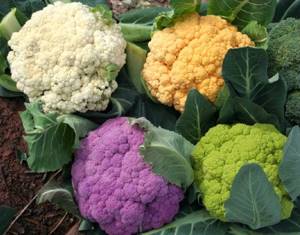
Cauliflower, a relative of broccoli and cabbage, is an annual crop and belongs to the cruciferous family. The foliage color is green, the inflorescences are cream, white or purple.
Cultivation of a variety of cauliflower began in Syria. Therefore, the vegetable was originally called Syrian, and the taste was somewhat different from the modern product and had a slight bitterness. The plant was then brought to Cyprus, from where it was imported to European countries.
In Russia, cauliflower was purchased for titled persons. During the reign of Catherine the Great, who initiated the import of vegetables into the country, the first attempts were made to grow the crop. But due to climatic conditions, they all ended in failure. Later, breeders developed a variety adapted for cold climates.
Among the people, the culture has several names that characterize its appearance - curd, curly.
Composition and calorie content of cauliflower
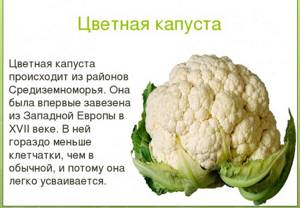
Nutritionists know exactly how cauliflower is beneficial for the body. 100 g of vegetable contains no more than 30 kilocalories.
On this topic:
Beneficial properties of wolf berries or how poison became medicine
Aug 16, 2020
What are the benefits of Brussels sprouts for human health?
Aug 5, 2020
BACK FORWARD 1 of 57
At the same time, the vegetable contains many vitamins that a person needs not only during a diet, but also in everyday life:
- Vitamin A. Helps strengthen bones and teeth, strengthens the immune system, prevents the development of problems with the cardiovascular system, vision, slows down the aging process, and participates in the regeneration of damaged cells.
- B vitamins. Help strengthen the immune system, participate in the fight against a number of diseases, increase vitality, and normalize hemoglobin levels.
- Vitamin E is what cauliflower does for women. Participates in restoring hormonal levels and normalizing the menstrual cycle. The vitamin also helps men. By using it, you can avoid problems with sexual activity.
- Vitamin C is an essential component for strengthening the immune system.
- Nicotinic acid or vitamin PP. Controls blood cholesterol levels, helps eliminate blood clots, and improves blood flow.
- Vitamin K. Essential for normal wound healing as it improves blood clotting.
- Vitamin N. Promotes rejuvenation of the body and maintains skin elasticity. Essential for healthy hair.
A unique set of microelements
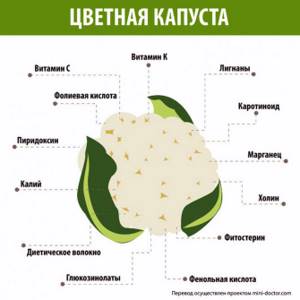
In addition to vitamins, cauliflower contains fiber and a number of useful microelements:
- Magnesium. Participates in the normalization of blood pressure. Prevents the formation of kidney stones. Necessary for strengthening the nervous system and normal muscle function.
- Phosphorus. The main component for strengthening bones and teeth. Helps increase libido.
- Iron. Participates in the processes of hematopoiesis, enriches the body with oxygen. Iron deficiency leads to weakness and risk of fainting.
- Selenium. Necessary to protect the body from bacteria and viruses, normalize the growth of nails and hair. Has a positive effect on the reproductive system.
- Zinc. Necessary for increasing muscle activity, strengthening bones and normalizing the condition of the skin.
- Copper. Participates in the formation of hemoglobin, normalizes insulin.
- Manganese. Prevents the effects of allergens on the body, strengthens the nervous system, and helps restore the reproductive system after infectious diseases.
- Sodium. It is the main component for regulating water-salt balance.
- Potassium. Reduces the risk of edema, removes toxins and waste.
- Calcium. With a lack of microelement, the risk of fractures increases, tooth enamel becomes thinner, nails and hair become brittle.
All of the listed vitamins and microelements are contained in cauliflower in large quantities. Therefore, eating vegetables allows you to compensate for their deficiency. At the same time, when asked whether it is possible to eat raw cauliflower, experts answer in the affirmative. It is the fresh vegetable that retains most of its beneficial properties.
How to cook cauliflower deliciously - tips
- A fresh head of cabbage is cleared of leaves and divided along the stalk into two or three pieces. All dark places and black dots are removed.
- The vegetable is prepared for cooking: insects are removed, divided into inflorescences.
- A suitable pan is selected, a sufficient amount of water is poured in and the container is placed on the fire.
- Add salt to taste. The liquid is brought to a boil.
- Inflorescences are placed in boiling water.
- To prevent the cabbage from darkening during the cooking process, it is recommended to add a small amount of vinegar (a tablespoon is enough).
- Boil the inflorescences for up to 10 minutes. If necessary, you can check the readiness to taste.
- The finished vegetable is placed in a colander.
To make the product as healthy and tasty as possible, it is recommended to take note of the following tips:
- Cabbage should only be placed in boiling water. If this condition is not met, the inflorescences may lose their shape.
- You can boil cabbage not only in water, but also in milk. This way it will have a more delicate taste.
- When choosing cabbage, pay attention to the forks. If they are dense enough, then such a vegetable is better suited for use in salads or main courses. If it’s loose, it’s the best option for soup.
If you do not plan to immediately prepare a cauliflower dish, it is best to store it in a dark, cool place with normal humidity.
If you know how to cook cauliflower correctly, you can easily prepare healthy and light dishes that will undoubtedly please both guests and family. This vegetable goes well with other foods in soups, salads and side dishes.
Cauliflower is a storehouse of useful microelements and vitamins. It is often used as complementary food for babies or as a dietary dish for people on a diet. It is possible to eat the vegetable raw if desired, but this option is to the taste of only some gourmets, so you need to learn how to deliciously prepare dishes from it, cook it correctly and serve ready-made culinary masterpieces. You can cook fresh cauliflower in several ways: classic (using a saucepan), in a slow cooker, double boiler or oven.
For several centuries, fresh cauliflower, at the initial stage of preparation, is boiled in a saucepan. This provides it with the necessary softness and helps to reveal the best taste qualities. This process takes a minimum of time and effort, and the finished result can amaze even the most demanding gourmets. What you need for cooking:
- Fresh cauliflower – 1 head.
- Small enamel saucepan.
- Table salt – a small pinch.
- Water.
Save the link right now so you don’t forget.
Step-by-step description of the process of how to cook cauliflower:
- Cut the cauliflower head lengthwise and divide into small florets. It is advisable to make all parts the same size so that they cook evenly and at the same time.
- Place the inflorescences in a container, add water so that it lightly covers the cabbage, and lightly salt.
- Place on high heat and let it boil. Cook vegetables for 7 minutes.
- If you cover the pan with a lid during cooking, the vegetables will turn yellow. To preserve the snow-white color, cook in an open container, and add citric acid, lemon juice or vinegar to the water at the tip of a knife.
- After the time has passed, remove the inflorescences from the water. The remaining broth is rich in vitamins and beneficial properties, so it is ideal for making soup.
In order to preserve the maximum beneficial properties of the vegetable, you need to cook it in a slow cooker or double boiler. This processing method requires a minimum of effort, but the process is a little longer in time than, for example, cooking in a pan. Cooking cauliflower using modern kitchen appliances is a real pleasure, and the resulting tasty and healthy vegetable will be enjoyed by all your close or unexpected guests.
To prepare you will need:
- Fresh cauliflower – 1 head.
- Water.
- Multicooker or steamer.
- A small pinch of salt.
Step-by-step cooking process:
- Soak the head of cabbage in cold water for fifteen minutes - this will help get rid of dirt and insects.
- Divide the product into equal inflorescences.
- Pour water into the bowl of a multicooker or steamer, place a steaming container on top, and place the inflorescences there.
- Close the lid of the device, select the “Steam” mode. The cooking time depends on the capabilities and functionality of the equipment, but you should roughly focus on the following indicators: multicooker - 13-18 minutes, double boiler - 25-30.
- At the end of cooking, put the product out and let it cool slightly before proceeding with further manipulations.
It often happens that there is very little time to prepare dinner, but you really want to please your loved ones with something tasty and healthy. The ideal option is cauliflower, and to save time on boiling, this process should be done in the microwave. To prepare you will need the following ingredients and attributes:
- Fresh cauliflower.
- Water – 3-5 tbsp. l.
- Salt – 0.5 teaspoon.
- Microwave container. It is important to remember: metal utensils cannot be used for cooking - this can lead to equipment breakdown.
How to cook cauliflower step by step in the microwave:
- Peel all the leaves, divide the head of cabbage into inflorescences and rinse thoroughly under running cool water.
- Place the vegetables in a bowl, add a few tablespoons of water and a pinch of salt.
- Cover the container with a lid and place in the microwave.
- Turn on the microwave at full power and cook for four minutes, then stir the inflorescences and cook for another 3 minutes.
- It’s very easy to check for readiness - the stems become softer and can be easily pierced with a knife.
The original way to cook cauliflower is in the oven. Not many people know it, but the resulting dish will not leave indifferent even a person with the most sophisticated taste preferences. In order to cook vegetables you will need the following ingredients and accessories:
- Baking tray with high sides.
- Fresh cauliflower.
- Milk – 3 tablespoons.
- 3 chicken eggs.
- Hard cheese – 150 grams.
- Greens to taste (dill, parsley, herbs).
- Peel fresh cauliflower from green leaves and divide into inflorescences.
- Rinse thoroughly under running cool water.
- Place in an enamel pan, add salt, a little water, boil and cook for ten minutes.
- Rinse under running water and place in a baking tray pre-greased with vegetable oil.
- In a separate container, beat eggs with milk and add herbs. Pour the mixture over the vegetables, sprinkle with grated cheese.
- Place in the oven for 20 minutes until completely baked.
- An amazingly tasty and healthy snack is ready. This dish is suitable for a quiet family dinner or for a small celebration.
In order to enjoy tasty and healthy vegetables in winter, they must be prepared in the summer by freezing. Ingredients:
- Cauliflower.
- Citric acid.
- The water is boiling and cool.
- Cooking container and storage bags.
To ensure that freshly frozen cauliflower does not darken and retains its best beneficial qualities, you must follow these steps, observing the following rules:
- First of all, you need to carefully choose a vegetable: the head of cabbage should be dense, without visible dark spots, limp elements or other damage.
- Divide the vegetable into inflorescences of the same size; do not make too large parts.
- Thoroughly wash all inflorescences from possible dirt, insects and the results of chemical treatment.
- In order to preserve the snow-white color of cabbage, you must perform the following steps:
- Place the inflorescences in a saucepan with boiled water for a few minutes.
- Using a slotted spoon, remove the inflorescences and place in cool water or simply rinse with cold liquid.
- You need to add citric acid to boiling water, the proportion is 1/3 teaspoon per liter of water. This mixture will help prevent vegetables from browning.
- Place the inflorescences in boiling water with citric acid and simmer for about three minutes until they begin to float.
- Place the vegetables in a colander and place on a paper towel to absorb excess liquid.
- Pack vegetables in bags or plastic containers and place in the freezer.
Cauliflower, extremely rich in vitamins (especially vitamin C), mineral salts and protein (in amino acid composition not much inferior to animal), has significant nutritional value for humans. Due to the balance of the complex of biologically active substances and its fine cellular structure, cauliflower is easily absorbed by the body, which, unlike other types of cabbage, allows it to be used in dietary nutrition.
We suggest you read: How to properly plant zucchini seedlings
Selection and primary processing of cauliflower There are many different varieties of cabbage available for sale, but the ones with white heads are the most highly prized. Gray and greenish ones taste rough and bitter. Fresh inflorescences should be dense and elastic to the touch at the base and without a brown coating on top.
The green leaves surrounding the head of cabbage are usually not eaten and are thrown away. To remove possible pests, cabbage is immersed in cold salted water for about thirty minutes. The emerging caterpillars are thrown out and the vegetable is washed.
For portioned dishes, the heads of cabbage are boiled whole; for side dishes, they are disassembled into inflorescences. Cauliflower can also be eaten raw.
Methods for cooking cauliflower
- Steamer, convection oven, multicooker, microwave oven - these modern household appliances allow you to cook cauliflower with minimal loss of its nutritional value and taste.
- Frying is a popular and long-known method of cooking cabbage. It is recommended to first boil it or pour boiling water over it to remove bitterness (if any) and to preserve the juiciness of the finished product after frying.
- Pickling.
- Baking in the oven or Russian oven. The last option is the best.
- Boiling is the most common way to prepare cauliflower.
- When purchasing a product, you need to focus on its expiration date. Cauliflower should look good and not smell bad.
- Before cooking, the head of cabbage must be disassembled into inflorescences and washed well. This procedure helps rid the cabbage of small insects. You need to rinse the cabbage for about 15 minutes.
- You need to choose only fresh cabbage - whitish in color, with fresh leaves, and not flabby.
- You need to choose cabbage in a transparent bag, without water and snow.
- Wash the medium-sized cabbage, peel it, divide it into inflorescences, and then place it in a bowl in a double boiler.
- Steam for 15-20 minutes.
- Meanwhile, the cream sauce is being prepared. For it, prepare 250 grams of heavy cream, pepper and salt. The sauce is whipped, finely chopped fresh herbs and onions are added to it, and mixed.
- The finished cabbage is taken out of the steamer, divided into portions, and poured generously with sauce.
The benefits and harms of cauliflower
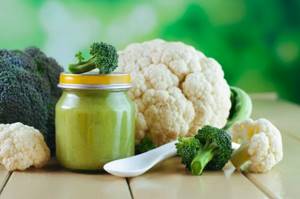
At the same time, only the taste of the product is appreciated. In fact, the vegetable has the following properties:
- choleretic;
- soothing;
- laxative;
- antitumor;
- restorative;
- antimicrobial;
- choleretic;
- antidepressant;
- anti-inflammatory;
- regenerative;
- antioxidant;
- antiulcer;
- rejuvenating.
In addition to its positive qualities, cabbage has a number of harmful properties.
Therefore, the vegetable is not recommended for people with pathologies such as:
- hypertension;
- problems with the thyroid gland;
- ulcer and gastritis during exacerbation;
- kidney pathologies;
- gout;
- heart failure;
- allergy to cruciferous plants;
- previous surgical interventions in the sternum and abdominal cavity.
Doctors do not prohibit this category of people from eating cauliflower. Vegetables can be included in the diet in limited quantities.
Before frying
In order to rationally organize the cooking process, you need to know in advance how long a particular stage will take. Cooking cauliflower takes a little time, however, it may vary depending on its condition and purpose.
After boiling:
- fresh vegetable is cooked for about 10-12 minutes in a pan;
- frozen - 12-15 minutes;
- after the water has boiled - 7-10 minutes;
- 4-5 minutes left before frying (until half cooked);
- steam - about 20-25 minutes until soft;
- in soup - 10-11 minutes.
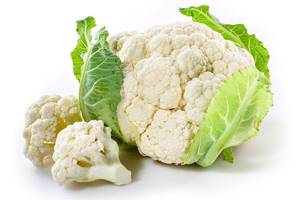
At the same time, it is worth considering that the given time is indicated for cooking in its entirety. Cabbage, disassembled into inflorescences, cooks 2-3 minutes faster.
Experienced housewives know that it is recommended to boil this product before frying. After these manipulations, you will get a nutritious, low-calorie and very tasty side dish for meat and fish dishes. Properly selected oil with spices will give it a special taste. Inflorescences fried in batter are no less delicious.
How long to cook vegetables before frying:
- 7 minutes - in a saucepan;
- 20 minutes – steam;
- 10 minutes - in a slow cooker;
- 3 minutes - in the microwave.
Due to its rich chemical composition and beneficial properties, this vegetable is widely used in cooking for preparing first and second courses, and baby food. However, not all housewives know how to prepare a delicious soup with cabbage inflorescences. There are many recipes for such a dish. How long to cook cauliflower in soup depends on the cooking method. As a rule, it is ready within 12-15 minutes after immersion in boiling broth.
Before boiling, it is advisable to put the cauliflower in a saline solution, which is made at the rate of 2 tbsp. l. salt per 1 liter of water. This is done to get rid of caterpillars and larvae. Next, you need to cut off all the dark spots from the head of cabbage and divide it into inflorescences.
The easiest way to cook cauliflower, both fresh and frozen, is in a saucepan. This is primarily due to the opportunity to taste the readiness of the vegetable.
Cooking cauliflower can be divided into several stages:
- Prepare the vegetable - remove excess parts, trim off the darkened parts, wash thoroughly.
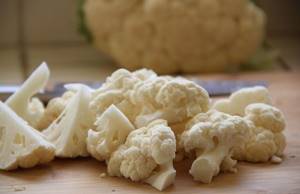
- Place a pan of water on the stove, add salt and wait for it to boil.
- Place the cabbage in boiling water without reducing the heat.
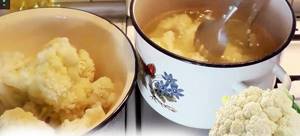
- When the water boils again, reduce the heat and cook until tender, 8-12 minutes. Such manipulations with fire allow you to preserve the color of the cabbage without allowing it to darken.
- Place the cooked vegetable in a colander to drain excess water.
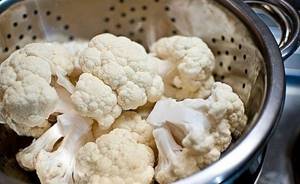
Cauliflower is a low-calorie product, which is why nutritionists love it.
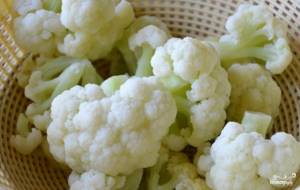
Despite its apparent simplicity, cauliflower can be prepared in many variations. It can be either a separate product or a component of a dish. Experiment, and ordinary borscht, but with cauliflower, will delight you not only with its appearance, but also with its unusual taste.
There are many dishes in cooking where cauliflower is the main or additional ingredient. This is a classic version of a fried vegetable in batter, simply boiled, marinated or with a special sauce. In any recipe, before starting cooking, fresh cabbage should be boiled. But this process is very scrupulous, because you need to know how long to cook it so that it does not boil over and lose its beneficial properties and taste. Cooking cauliflower:
- 7 minutes - in a saucepan before further frying the vegetable.
- 30 minutes - in a double boiler at full power.
- 15 minutes – cooking using a multicooker.
- 3-5 minutes - in the microwave.
You can boil cauliflower in different ways. Traditionally it is cooked in a saucepan.
- Cut the washed vegetable into inflorescences with a knife.
- Boil water in an enamel saucepan. Salt and place the inflorescences in the water.
- Boil them for 15 minutes over medium heat and drain in a colander.
In addition to the pan, you can cook the inflorescences in a pressure cooker, microwave, multicooker, or double boiler. In this case, you must adhere to the main cooking rules:
- Do not defrost frozen vegetables, but immediately place them in cold water, add salt and boil;
- Before cooking, divide it into inflorescences and keep a little in salted water;
- if you plan to fry it, then boil it first until half cooked;
- for boiling, use an enamel container;
- To prevent the vegetable from acquiring a yellowish tint, do not cover the container with a lid when cooking;
- To prevent it from darkening during cooking, add 1 tbsp to the water at the end of cooking. vinegar;
- cook the cabbage over medium heat.
After boiling cauliflower, you can eat it as an independent dish or serve it as a side dish.
Boil the cauliflower in a saucepan for about 15 minutes. If you plan to stew or fry the inflorescences in the future, the cooking time is reduced to 7 minutes; the half-finished inflorescences can be poured with egg sauce and made into a casserole or fried in batter.
And this is how long the cooking process lasts if other units are used:
- In a microwave oven, the vegetable is cooked in 2 stages. First, place it in a microwave-safe container, do not add salt, and set the timer for 5 minutes. Then add salt and boil again, setting the timer for 4 minutes.
- Cook the vegetable in a slow cooker for 15 minutes.
- The cabbage is cooked in a double boiler for 30 minutes.
- In a pressure cooker, cabbage will be ready in 15-20 minutes.
The cooking time for fresh and frozen vegetables is not too different. Frozen cauliflower takes 2-5 minutes longer to cook.
Cauliflower is a low-calorie and filling product that is easily digestible. A properly cooked vegetable retains its beneficial qualities, and the inflorescences retain their original shape, so it is important to adhere to the basic cooking rules.
We suggest you read: How to properly water vegetables in the garden
Once upon a time - about 2.5 thousand years ago - cauliflower was a wild plant. Through the efforts of the Mediterranean peasants who lived in those distant times, the tasty and healthy plant was cultivated and began to be grown on their lands. However, cauliflower was initially grown exclusively in Egypt, Syria, and Persia.
The Arabs highly valued the crop for its healing and excellent taste properties; even the great healer of that time, Avicenna, was sure that in the cold it was cauliflower that could give a person strength. Together with the Arab conquerors, cabbage came to Spain, but the Syrians brought it to Cyprus. It was after this that the natural gift was called Cypriot cabbage.
In Europe, the French, British, Italians and Dutch gradually began to grow the product. Only in the 18th century did the vegetable appear in Russia, and at first exclusively on the tables of aristocrats. Today, all compatriots can purchase the product for preparing various dishes, and valuable advice from experienced chefs will help them prepare it correctly.
Before cooking, cauliflower should be divided into florets. You need to cook the inflorescences for 10-15 minutes. For subsequent frying, pre-cook the cauliflower for 7 minutes. If you cook cabbage in a double boiler, you need to cook it for 30 minutes. But in a slow cooker the product takes only 15 minutes. Pre-frozen cauliflower should be cooked for 15-20 minutes, but the product does not need to be defrosted.
In a saucepan
For cooking, it is best to use an enamel pan.
- The inflorescences are filled with water, which is pre-salted.
- Place the pan on high heat.
- After the water boils, you need to reduce the heat.
- Cook whole cabbage for 10-15 minutes, and separated inflorescences for 7 minutes.
- There is no need to cover the pan with a lid, otherwise the cabbage may turn yellow.
- To make the inflorescences white, you need to add milk (1/4 cup per 1 liter of water).
- In this case, it is better not to pour out the broth, since it contains many trace elements and vitamins.
In the microwave
- Place the cauliflower inflorescences in a special pan and cover with a lid.
- Add a couple of tablespoons of water to the dish and set the microwave to full power.
- It is enough to cook the cabbage in a microwave oven for 3 minutes at full power, then add salt and cook for another 4 minutes so that the product is sufficiently cooked.
- Place individual inflorescences in a special tray.
- Steam by turning on the appropriate mode on the device.
- The product is prepared for 15 minutes in a slow cooker, 30 minutes in a double boiler.
- You need to check the readiness of the cauliflower with a knife.
The effect of cauliflower on the body
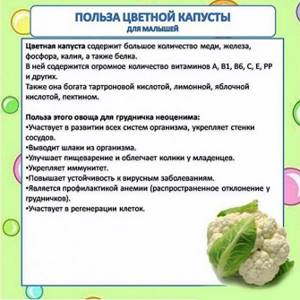
The benefits and harms of cauliflower are incommensurable. The vegetable has virtually no contraindications and is rightfully considered an ideal product for regular nutrition. Even with periodic consumption of the culture, the condition of the body can be significantly improved.
On this topic:
A universal herbal product - cedar oil,...
We explore the beneficial properties of butcher's broom and prepare healing…
We compare the beneficial properties of the herb cupina and its dangers for...
We reveal the secrets of how to properly ferment cabbage for the winter
BACK FORWARD 1 of 30
In cauliflower, the inflorescences are usually eaten. They have a beneficial effect on human health and help to recover from infectious and viral diseases.
Culture also helps:
- Strengthen blood vessels. This prevents problems with the cardiovascular system and avoids the development of stroke.
- Normalize intestinal microflora. The vegetable is rich in fiber, which contributes to the proper functioning of the gastrointestinal tract.
- Reduce the risk of developing cancer.
- Normalize cholesterol.
- Heal the formed ulcers on the mucous membranes of the stomach and larynx.
- Strengthen the nervous system.
- Enrich the body with vitamins and microelements while following a diet and during the recovery period after suffering pathologies.
Cauliflower is used as first complementary foods for children from six months of age.
What are the benefits of cauliflower for women?
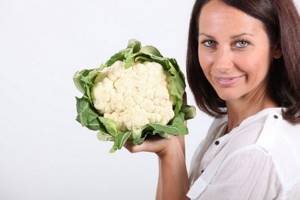
The benefits and harms of cauliflower were assessed by women. The vegetable is a storehouse of useful microelements. Helps rejuvenate the body not only from the outside, but also from the inside.
The main advantages of culture:
- Normalization of hormonal levels. Cabbage helps women get their menstrual cycle in order.
- Facial rejuvenation. Cauliflower juice promotes cell regeneration. It is also used to rinse hair to give it health and shine.
- Elimination of depression during menopause and other hormonal changes in a woman’s body.
- Prevents obesity. The culture prevents the accumulation of fats, while compensating for the deficiency of most vitamins and microelements.
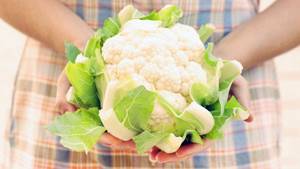
Cauliflower can be consumed even during breastfeeding. It does not cause fermentation in the intestines of mother and child.
The benefits and harms of cauliflower for men
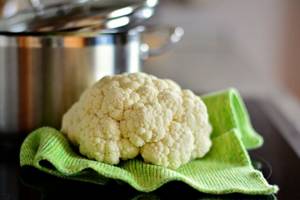
The benefits of thermally processed and raw cauliflower for men are also high.
The main features of the vegetable:
- Prevention of the development of tumor-like formations of the prostate gland.
- Improving male sexual abilities.
- Eliminate the risk of premature baldness.
- Prevention of obesity and heart problems.
Cauliflower helps men maintain vitality and restore strength after heavy physical activity.
Subtleties of cooking
To cook tasty and healthy cauliflower, follow the subtleties of its preparation:
- Before cooking, divide into inflorescences, rinse, and soak for 10–15 minutes in salted water to remove all debris.
- When cooking in a saucepan, dip the vegetable into boiling water and cook without covering.
- To keep the vegetable white, add ¼ tbsp to 1 liter of water. milk or 1 tbsp. l. vinegar.
- Check the readiness of the product with a knife. Sometimes cabbage cooks faster.
- Do not cook the inflorescences before frying, otherwise during further heat treatment they will lose their shape and appetizing appearance.
You can cook cauliflower in the classic way in a saucepan or using kitchen appliances: in a slow cooker, double boiler, microwave. In order for it to retain its benefits and turn out tasty, prepare it correctly, follow the cooking technology and cooking time.
The use of cauliflower in folk medicine
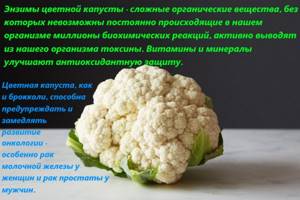
Information about whether cauliflower leaves can be eaten can be found not only in traditional medicine recipes. Almost all parts of the culture are eaten, as they are enriched with vitamins and microelements. Cabbage leaves are successfully used to relieve skin inflammation, heal cuts and other wounds.

There is also confirmed data on how the vegetable helps and how it is used in folk medicine:
- Stomach ulcer. It is necessary to drink juice daily - 0.5 tbsp. half an hour before meals.
- Cleansing the liver, bowel movement for constipation. To do this, use vegetable brine - 200 ml after meals.
- Haemorrhoids. To cure nodules, you need to drink 500 ml of warm brine daily.
- Inflammation of the gums. The juice must be diluted with water in a ratio of 1 to 1 and rinse your mouth with the solution.
- Dandruff and hair fragility. Rubbing a small amount of juice into the scalp every day can cure seborrhea and nourish the scalp.
When crushed, cabbage leaves and inflorescences are used as face masks.
Cooking rules
Fresh cauliflower should be a light whitish-milky color. Yellow or dark gray spots on the inflorescences are unacceptable. Limp leaves indicate that the heads of cabbage have been lying on the counter for a long time. By choosing a fresh product, you will get more benefits from it. But due to the leaves and stalk it will be more expensive.
If you decide to purchase a frozen product, it is better to choose it in transparent packaging. This makes it easier to determine quality. You should not overpay for a large amount of snow in the package. Medium-sized inflorescences should be light. By choosing a frozen vegetable, you are depriving yourself of some nutrients. But due to the absence of stalks and leaves, it will be cheaper. And it’s more convenient to cook frozen buds.
You can cook this vegetable in different ways. But it is better to cook frozen inflorescences in the traditional way - in a saucepan. This makes it easier to control the readiness of the product. The buds should retain some crispness and not turn to mush.
Before you start cooking cauliflower, you need to separate it into inflorescences and rinse well under running water. If there are doubts about the quality, the buds can be soaked in salted water before cooking. All debris and insects will rise to the surface of the water.
Disassembled into inflorescences, cabbage should be placed in boiling, pre-salted water. If you place it in cold water, then during the cooking process the buds will lose their shape and simply fall apart. After boiling, the heat must be reduced and continued to simmer over low heat. Readiness can be easily determined with a knife. After the inflorescences are cooked, they need to be thrown into a colander.
| Cooking method | Cooking time |
| Pot | Fresh – 10 – 15 minutes Frozen – 15 – 20 minutes |
| Multicooker | Fresh - 20 minutes |
| Double boiler | Fresh - 30 minutes |
| Pressure cooker | Fresh - 4 minutes |
| Microwave | Fresh – 3 – 5 minutes |
Before frying, the vegetable should be cooked for less time. After all, additional heat treatment can lead to it becoming too soft and tasteless. Before frying, it is enough to boil it for 4 - 5 minutes.
To prevent the buds from acquiring an unpleasant grayish tint during the cooking process, add one of the ingredients to the water after boiling:
- half a liter of milk for 1.5 - 2 liters of water
- 1 teaspoon lemon juice for the same amount of water
- citric acid on the tip of a knife
- a few drops of 70% vinegar essence
- Cooking time: 30 minutes;
- Number of servings: 4;
- Calorie content of the dish: 30;
- Purpose: for lunch;
- Cuisine: European;
- Difficulty of preparation: easy.
You can cook this vegetable not only over fire, but also by steaming it. At the same time, much more vitamins will remain in the finished dish. The cooking time for cauliflower does not depend on whether you use frozen or fresh product. You can use steamed inflorescences for dietary or baby food, as a side dish. In addition, they are used to make soups or light purees.
Ingredients:
- cauliflower – 800 g;
- salt;
- spices.
Cooking method:
- Prepare a head of cabbage and separate it into inflorescences.
- Place on a steamer tray. Freezing can be used without defrosting.
- The product is salted and spices are added.
- Set to steam for 25 minutes (pre-defrost vegetables for 7 minutes).
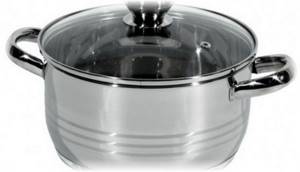
In order for the prepared cauliflower dish to have a pleasant taste and retain all the beneficial qualities of the product, it is necessary to pay maximum attention to the choice of vegetables. The ideal option is to grow the product in your own garden; this will be a 100% guarantee of the absence of chemicals and various types of processing. If this is not possible, then when buying a vegetable at the market or supermarket, you should consider the following nuances:
- A medium-sized head of cabbage would be ideal for cooking.
- The leaves should be green, without fading or obvious damage.
- Inflorescences are white, clean, without black spots or defects. You should not buy a head of cabbage from which the tops have been cut off; this is a sure sign that the product has begun to deteriorate and the damage was cut off to give it a marketable appearance.
- The head of cabbage should be elastic, but not heavy.
Cauliflower is a very healthy product that, when properly prepared, is also very tasty. Many people don’t like it, but most likely the reason is that not everyone can prepare it in such a way as to simultaneously preserve both its properties and taste.
Cooking cauliflower in creamy sauce
From this product you can prepare a huge number of dishes, both individual and those where cauliflower will be an additional ingredient. Some of them are good for regular meals, others are even suitable for holiday tables.
The simplest and most popular cooking method is boiling. If you follow the instructions, the dish will pleasantly surprise and delight you. Even picky children who are usually indifferent to boiled vegetables will love it.
Frozen Cauliflower
- pot
- fresh cauliflower or frozen
- water
- salt
- milk or citric acid in case you do not want to allow the inflorescences to darken
Fresh cauliflower should be white and firm. The presence of spots on the leaves is unacceptable, and the yellow color indicates that it has been lying on the counter for a long time and has lost its taste. Withered leaves and inflorescences indicate the same thing.
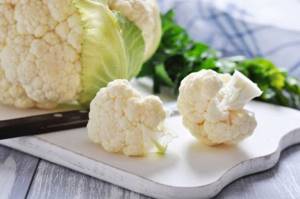
If you want to purchase a frozen product, then pay attention to the packaging: if it is transparent, then all the shortcomings can be noticed in the store. If not, then you can only rely on the expiration date and your trust in the manufacturer. The required degree of maturity is indicated by the size and color of the inflorescences: they should be of medium size and light, darkening indicates deterioration.
When frozen, cauliflower loses some of its beneficial qualities, but it will be cheaper. It also requires less effort when cooking than fresh, because the manufacturer has already done the work of separating the edible part from the unnecessary leaves and head of cabbage.
We invite you to familiarize yourself with: Bell peppers stuffed with cabbage for the winter
Please note that cauliflower has an expiration date, so keep an eye on the production date. If it is not indicated on the package, then it is better not to risk it and buy it somewhere else.
Cabbage is spoiled not only if it has rot, it can also be “sick”: this is indicated by characteristic spots.
Increasingly, when preparing various dishes, housewives use not only traditional means, but also kitchen assistants: a multicooker, a double boiler, a pressure cooker, a microwave oven. The cooking technology in them is slightly different from the traditional one - in a saucepan.
Multicooker
In this device, it is most convenient to cook cabbage in the “Steam” mode.
- The vegetable is divided into small inflorescences.
- The product is placed in a bowl, after which a sufficient amount of water is poured into it. The liquid should only cover the cabbage halfway.
- The lid closes. The “Steaming” (or double boiler) mode is set for 20 minutes.
Video recipe for cooking cauliflower in batter.
Microwave
The cooking process in the microwave is somewhat different from the traditional one. 0.5 kg of cabbage is pre-cleaned and prepared.
- The inflorescences are placed in a glass container or other suitable container so that the stems extend from the center.
- A small amount of water is added.
- The container is placed in the microwave and covered with a lid.
- The power is set to 800 watts. Time 5-7 minutes.
- After the time is up, the cabbage is taken out, salted and put back.
- Additionally, it is cooked at the same power for 4-5 minutes.
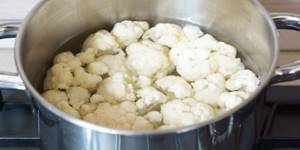
If you don’t have a steamer or a multicooker with a steaming function at hand, cabbage can be cooked in a simple device consisting of a saucepan and a metal sieve.
- Water is poured into the pan, placed on the fire, and brought to a boil.
- Pre-prepared and disassembled cabbage is placed in a sieve.
- The structure is covered with a lid on top.
- To understand whether a vegetable is ready, just use a knife or fork. When pierced, the vegetable should be soft.
After cooking, the cabbage needs to be salted.
Cauliflower selection and storage
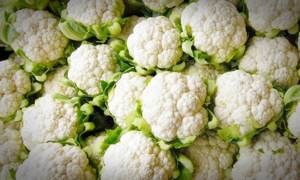
In order for cabbage to be as healthy as possible, it must be chosen correctly. Only a healthy vegetable that has been properly preserved contains all the vitamins and microelements.
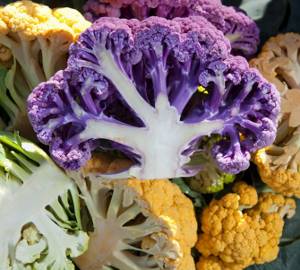
For eating, it is better to choose heavy and strong heads of cabbage. There should be no spots or sores on the leaves and inflorescences. Cabbage is stored in the refrigerator at a temperature of 0-2 degrees for 10 days.
When eating cauliflower, the main thing is not to kill its beneficial properties. Experts recommend boiling or baking the vegetable and eating it raw.
Ingredients
- Cauliflower – 600 grams
- Salt - To taste
- Cauliflower 600 grams
- Salt To taste
Wash the head of cauliflower thoroughly and separate it into florets.
Place the cabbage in boiling, salted water and cook for about 10 minutes.
It has long been known that cauliflower has an amazing, incomparable taste and a huge number of useful and even healing properties. The vegetable is available to everyone; it is very popular among adherents of proper nutrition, people who want to maintain ideal shape and good health.
- Cauliflower – 200 g
- Salt – 1 tsp.
- Water – 500 ml
